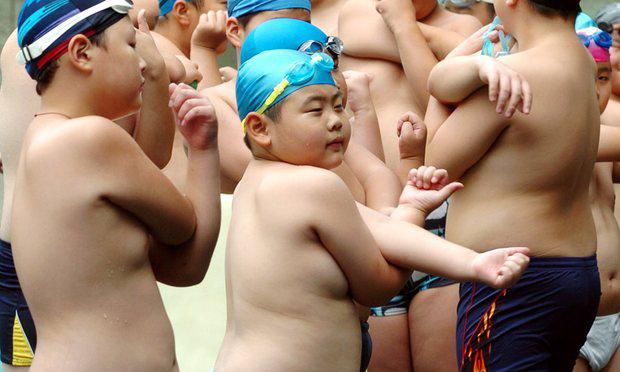
There’s a direct link between urbanization and increased food consumption and obesity issues in China, and it has become a growing epidemic. Dr Xu Zhangrong, deputy secretary of the China Diabetes Society has said that “the sudden rise of diabetes in China isn’t only a health threat but an economic one. It could bankrupt the country’s healthcare system. China needs to shift its focus from treating diabetes to preventing it”. Within one generation, the percentage of Chinese children who are overweight or obese has skyrocketed from 5% to 20%. The rate has absolutely exploded, over a very limited amount of time.
But why is this happening? The main cause is our increasingly sedentary lifestyle, combined with the introduction of highly processed fast food and adoption of western aspirations.
The one-child policy meant that a whole generation of children growing up as the only child doted on by their two parents and four grandparents, which means they can have a large say in dictating what the household purchases. The problem is compounded by the fact that this generation of parents grew up not having a lot. I remember my mother telling me stories of her youth - that they were so poor that they only ate a portion of pork once every few months. Now, its not uncommon for Chinese households to have two or three investment properties. Within a generation you have people who have accumulated a lot of wealth which of course they want to give to their kids. They want to give them everything they never had, so if their kids want McDonalds, if they can afford it, why shouldn’t they? It’s a sign of affection. And Chinese people love showing their affection with food.
But it’s the introduction of western aspirations and fast food which has allowed the habits to take such a sharp turn. KFC is the number one food chain here and there are also a lot of Chinese chains that are unhealthy as well. The flavors are intensifying and everything has to be amplified which means more salt, more sugar, more fat in everyone’s diet.
The idea for our A New Way to Eat project was developed by Joint US-China Collaboration on Clean Energy (JUCCCE), which looks for “acupuncture points” to accelerate the greening of China. We realized that food is a great way to engage people on the issue of sustainability. Our food system is the single largest driver of greenhouse gas emissions and we realized that food is a big part of Chinese culture, so it is a great way to engage people on the issue of sustainability and communicate messages about personal and planetary wellbeing.
A New Way to Eat is a behavioral change program. The concept behind it is to take complex subjects like sustainability, biodiversity and micronutrients and translate them into a language that kids can understand and relate to. For instance, one of the catchy themes we have developed is “eat a rainbow everyday” because if you eat a variety of colors every day, you are getting all the micronutrients you need. In order to make it memorable for kids we’ve created theme songs (Chinese and English), activity sheets, discussion questions and visually stimulating flash cards. We even dress up in “food heroes” costumes. We paint, we draw, we make them run around and get active, and get them engaged with healthy eating.
We specifically target young urban kids, because they are the emerging middle class. It is much easier to instill healthy habit when you’re young rather than trying to change entrenched unhealthy habits when you’re a young adult.
The program is based on “playducation” which is a different and innovative approach to the current education system here. Basically, you have the teacher at the front, talking for the entire length of the class, it’s fairly didactic. Therefore, our classes have been exceptionally well received – kids love it. We’ve had parents tell us they catch the kids singing the jingles even a week after class, which shows us our approach works.
We’re currently piloting our program with a few schools and hope to roll out the program nationwide and make our content open source to all schools within China in the next three to four years.
Also, we are working with school cafeterias and local chefs to reframe their recipes, so that whatever the kids learn in class they see on a plate at lunch. We promote a lot of leafy greens for calcium, beans and legumes and tofu for protein – China has hundreds of varieties of tofu.
We have faced some challenges with parents’ entrenched misconceptions about how much milk or meat their kids should be consuming. We can’t tell them they are wrong, so we have to try and work around this and hopefully they will come to their own realization in time. A lot of parents also say, we’re not vegetarians, we can’t not eat meat. The conversations become fairly polarized – you either eat meat or you don’t. So we talk more about being smarter consumers, finding a medium ground. We’re not saying don’t eat meat, just be smarter about how you’re consuming meat. Instead of eating a steak, you can eat three meals of stir-fry dishes that use the same amount of meat. Funnily enough these are more traditional Chinese dishes, and they just so happen to be better for you and the planet too.
The other side of the coin is the food industry we’re competing with. They have such marketing power. A lot of people, especially young kids, are being bombarded with messages about unhealthy food. And it is clearly working, just look at this generation’s obesity rate! Our communities need to learn that healthy and balanced eating is good for us and good for the planet.
Source: The Guardian
 FR
FR EN
EN AR
AR








